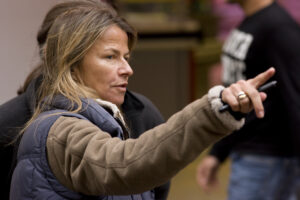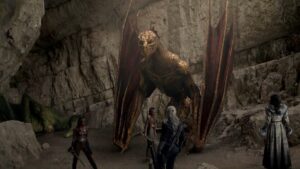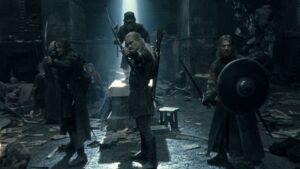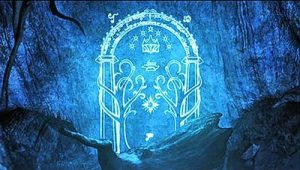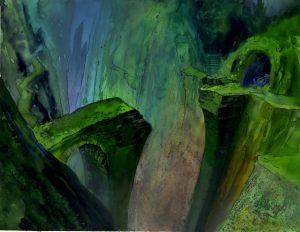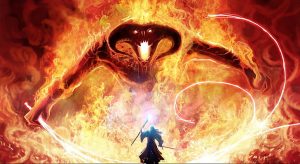The slow and unpredictable trickle of information from the set of Amazon’s The Lord Of The Rings has not provided solid ground on which to build a fandom or even a following for the upcoming series. I think a fair number of us in the Tolkien community are definitely excited, but I think many folks are simply…curious, and still more don’t even know that a new adaptation of The Lord Of The Rings is on the way because Amazon has done virtually nothing to promote interest in their biggest fantasy series, much less clearly establish to general audiences that this show isn’t – technically – an adaptation of The Lord Of The Rings, but of the book’s lore-heavy appendices.
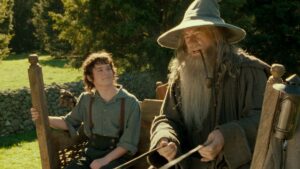
And that’s why leaks are so important. Leaks can increase or deflate public interest in a project far more effortlessly than a studio press release…and in “power vacuum” situations like this one, where the studio in question isn’t even interacting with their target audience yet or attempting to turn the narrative in their favor, leaks and rumors are especially vital. They can also be dangerous, as evidenced by the ongoing backlash to a rumor that Amazon would feature nudity and sexual activity in their adaptation of The Lord Of The Rings.
But today, TheOneRing.net (colloquially known as TORn) presented us with a bundle of set leaks, together forming the most substantial and invigorating information about Amazon’s The Lord Of The Rings since filming began, well over a year ago. Obviously, everything in these leaks is unconfirmed, and should be treated as rumor rather than fact, at least for now. But that being said, some of it lines up with other things we’ve heard or guessed, and I don’t doubt that TORn still has access to a reliable network of veteran spies across New Zealand. They claim to have verified most of the leaks with sources working on Amazon’s series, which is also an encouraging sign.
I, of course, will be running through each item on TORn’s bullet-point list of leaks based on my own personal interest: a ranking, of sorts. There’s a lot here, some of which could even form the basis of individual posts, if anybody would be interested.
The biggest news to come out of the leaks is that Amazon has apparently obtained rights to what TORn describes as “elements” and “passages” from The Silmarillion. This would confirm that Amazon’s deal with the Tolkien Estate, first forged in late 2017, is constantly evolving – perhaps because, as TORn claims, the Tolkien Estate is more closely involved with Amazon’s The Lord Of The Rings than with any previous Tolkien adaptation, and is apparently “very happy” about the direction the series is taking. I know for a fact that Tolkien fandom will be of two minds about this: some people will get excited by the prospect of an adaptation of The Silmarillion; others will be outraged by a perceived assault on Christopher Tolkien’s legacy. The truth, as TORn notes, is probably that the elements and passages in question are those contained in The Silmarillion‘s own appendices, which merely expand upon information in The Lord Of The Rings‘ appendices (and are further expanded upon in Unfinished Tales, but that’s a whole other set of rights).
A little further down TORn’s list, but higher up on mine, is news of a release date for the series: mid-2022, which matches up with recent reports obtained by Fellowship Of Fans from the New Zealand Film Commission detailing timeframes for Amazon’s marketing campaign. It’s not an exact date yet, but it would seem to suggest a late Spring or early Summer release, which sounds pretty good to me. Will I be digging through every text related to the Second Age of Middle-earth trying to find significant dates in that general timeframe on which Amazon might release the first season? You bet I will.
On a related note, TORn claims that “Main unit wrapped shooting in April 2021” – which again lines up with other reporting – and that while many of the cast have finished their work on season one and left New Zealand for the time being, there are still other “big stars” in the show that we haven’t heard about yet. No indication of whom, exactly, but this could tie into the very last point on TORn’s list: the identity of Sauron.
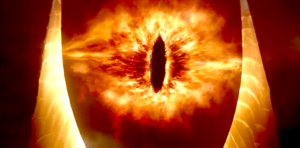
According to the leaks, Sauron “will not be revealed in Season One”, nor will his alter ego of Annatar appear: possibly dispelling rumors that season one will focus on the Forging of the Rings and Annatar’s betrayal of the Elves. But the wording there makes me think that instead, Sauron will appear in other forms throughout the first season, with several different actors portraying the shapeshifting deceiver as he navigates through Middle-earth in the Second Age. That means general audiences and Tolkien fans alike will be surprised when Sauron is eventually revealed, and a new actor could potentially take on the role going into season two – kind of like a dark twist on Doctor Who. This actor could very well be someone with the star-power to keep fans hooked on the show, and it would make for a great cliffhanger. It also means that Joseph Mawle, who joined the cast as season one’s unnamed main villain, isn’t playing Sauron – I still hope he’s portraying the man who will become the Witch-King of Angmar.
According to TORn, Celebrimbor is the character whom Tom Budge was set to play before leaving the role because of creative differences. The character has since been recast, although he may not have a very large part to play in season one given that this incident seems to have had no effect on filming dates. I also suspect that Celebrimbor doesn’t appear in the first few episodes, directed by J.A. Bayona, which serve as “a standalone entry point to the series”.
That latter bit of information lends credence to some previous reporting from TORn that Bayona’s episodes form a feature-length film. I’m gonna call it now, this feature-length film probably deals with the very end of the First Age and the early days of the Second; from the great migration of Elves, Men, and Dwarves across Middle-earth, to the construction and enrichment of their great kingdoms in Lindon, Númenor, and Khazad-dûm, respectively.
Fascinatingly, the new leaks claim that Elves, Men, and Dwarves all “have their own sequestered production units” on The Lord Of The Rings. I cannot wait to learn what that’s about, since, as TORn editor Clifford Broadway speculates, it could suggest some kind of anthology or split-narrative approach to season one that would also emphasize the deep divides between the Free Peoples – and underscore the immensity of the threat that will bring them together in the final days of the Second Age during the War of the Last Alliance. Foreshadowing; we love to see it!
Apparently, the ancient ancestors of Hobbits – referred to in the leaks as Halflings – will also make an appearance in the show, though the extent of their role is unknown. I’m conflicted about this, and I really need to know more about what Amazon plans to do with their Halfling characters before I can pass judgment. But the fact that the Halflings will be played by Black and brown actors, including Sir Lenny Henry, is promising: again, a lot will come down to the execution of this idea, which has roots in Tolkien’s own writing (prepare for the inevitable discourse about how Tolkien’s reference to Harfoot Hobbits being “browner of skin” was actually a reference to very tan white people). During the Second Age, very little is known about the Halflings or their movements across Middle-earth: I rather suspect that by the end of the series, we’ll find them settled in the Gladden Fields, where thousands of years later a Halfling known as Sméagol would come upon the One Ring in the muddy waters where Isildur died.
Moving on to the most controversial item on the list, we have the surprising and somewhat bemusing revelation that Elves will apparently have short or shorter hairstyles in Amazon’s The Lord Of The Rings. I’ve seen a lot of backlash to this idea already, but I’ve got to be honest – I’m into it. There’s definitely arguments to be had about just how many of Tolkien’s Elves had long flowing locks, because some most certainly did, but the instantly iconic image of universally long-haired Elves is mostly a Peter Jackson creation. This change suggests that Amazon isn’t constrained by Jackson’s continuity, and I appreciate that. On a similar note, the show apparently swaps out the Jackson term “Cave Troll” for “Ice Troll”. Minor change, but it’s little details like this that reinforce my faith in the leak overall.
Over in the pile of “things that were never controversial to begin with but got blown wildly out of proportion”, we have the subject of nudity…or “sexless nudity”, as TORn proudly declared in their headline today. You may remember that TORn led the charge against the very concept of nudity or sexuality in The Lord Of The Rings after learning that an intimacy coach had been hired for the series; but today, it turns out all their fears were unfounded, because the nudity in Amazon’s series isn’t even remotely sexualized. In depicting the transformation of Elves into monstrous Orcs by Sauron’s corruptive evil, The Lord Of The Rings will apparently involve nudity “suggestive of concentration camp-type visuals of victims”.
And whether or not TORn’s claims that Tolkien scholar Tom Shippey had been fired from the set of The Lord Of The Rings had any validity, the new leaks state that three unnamed Tolkien scholars “were on set for a time”. The language here is slightly deceptive – they may have been on set, but more importantly, what did they think of the set? Who are they, and was one of them Shippey? Are they no longer working on the show? Can I apply for this job?
Lastly, we have one truly bizarre piece of news. Amazon apparently has “a fake production team shooting decoy footage on fake sets” simultaneously to the real production. I…have no words for how strange and distasteful that is to me, but I pray to Eru Ilúvatar that some of this decoy footage has a purpose, and isn’t just meant to keep people away from the real set. I mean, it would be one thing if anybody had even gotten a good look at the fake set, much less the real one, but so far we’ve seen virtually nothing besides fences and walls of shipping containers. If they’re trying to deceive us, at least…uh, tell us what we’re supposed to be deceived by?
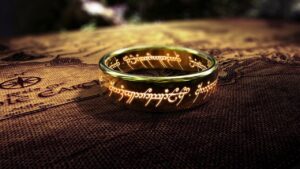
If Amazon is willing to go to such ridiculous levels to throw people off the scent, it’s hard to trust that this leak isn’t also a carefully planned distraction. But I hope it’s not, because I’m more excited now than I think I’ve ever been for this adaptation. Does this change your views on The Lord Of The Rings? Share your own thoughts, theories, and opinions, in the comments below!



